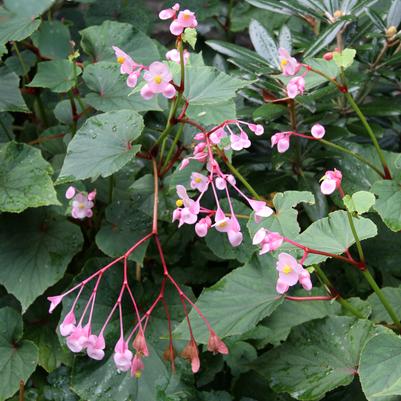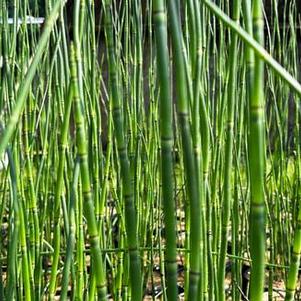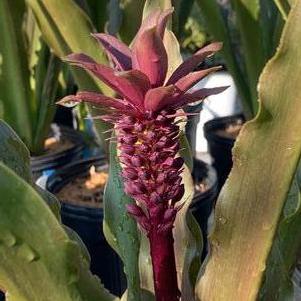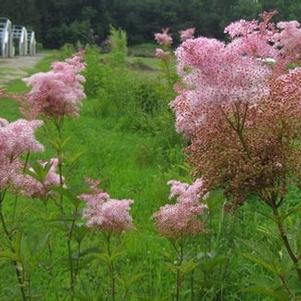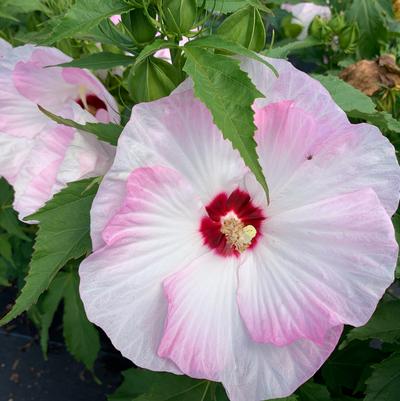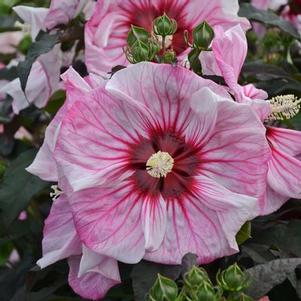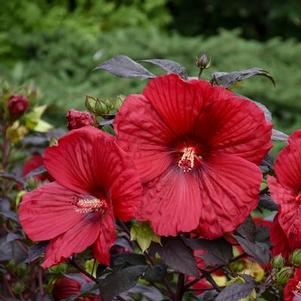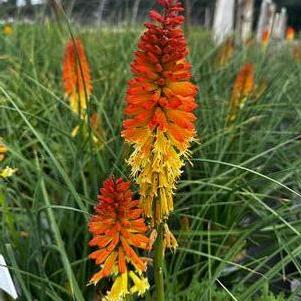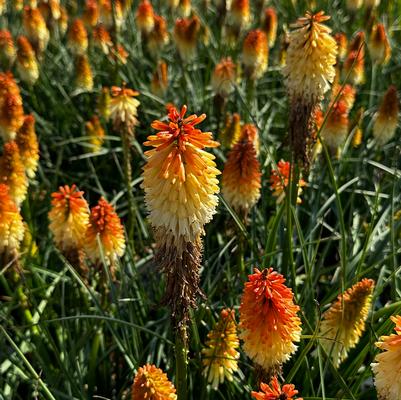Tropical Tricksters
With the dog days of summer upon us, many of us are craving a break from the humidity and bustle of getting ready for fall. However, what better to celebrate these muggy, hot days than by highlighting some tropical-esque perennials? If you can’t get away this summer, have no fear – we have just the right selections to bring a tropical feel to your landscape. So, hop on the safari bus and let’s get exotic!
Equisetum hyemale
Despite being a North American native, Equisetum hyemale brings a unique vertical quality to the landscape with its starkly upright, cylindrical aerial parts. Dating back to prehistoric eras as one of the first vascular plant species according to the fossil record, Equisetum hyemale, known commonly as scouring rush and horsetail, is more fern-like than it is perennial-like. Small, fertile, terminal cones produce spores typically in mid-summer, encouraging a healthy reproduction of the species not only by environmental factors but by prolific rhizomatous growth as well. Despite becoming somewhat aggressive in wet, poorly-drained areas, horsetail remains evergreen throughout the winter and adds an interesting textural component to the rain, wetland, or a low-lying spot in the medicinal garden. Traditional use of horsetail as a medicinal herb is said to promote bone, skin, nail, and hair health, as well as being a vulnerary (wound-healer), diuretic, and having many other potential benefits. Although there is limited clinical evidence to support these claims, horsetail has been used in traditional medicine practices since the Ancient Greeks and Romans.
Filipendula rubra ‘Venusta’
While you’re in the wetland garden, you may as well consider adding Filipendula rubra ‘Venusta’ for its upright growth and fluffy plumes of rose-pink flowers that attract summer pollinators. This Eastern native is known as Queen of the Prairie, and for good reason – commonly found in wet meadows throughout North America, large, attractive foliage makes a textural impact amidst graminoids and smaller forbs, while the misty panicles of flowers make for quite a show, occasionally reaching up to 8’ in height. Following its bloom period, attractive brown seedheads take place and remain showy throughout the end of summer and into fall. A prolific self-seeder, seedheads should be removed if spread is unwanted, although deadheading this plant will not encourage a second bloom and should only be performed if bushier growth is desired. This particular selection is so revered, in fact, that it’s received the Award of Garden Merit by the Royal Horticultural Society for its outstanding garden performance.
Hibiscus x Summerific® series
As you’re enjoying queen of the prairie’s fluffy pink plumes and trudging your way around the moist, boggy area, you’re likely to come across a smattering of gigantic hibiscus blooms, each the size of a dinner plate and floating above a dense patch of multi-colored, lobed foliage. We can’t talk about hibiscuses without mentioning the Summerific® series. Known for their bright, broad, bodacious blooms and an array of interesting foliar colors, there is a Summerific® rose mallow for everyone. Below, we’ve compiled a short list of floral and foliage colors for your reference when looking for the perfect Summerific® hibiscus.
Kniphofia spp.
Moving upland to drier pastures, we come to the full-sun-loving red hot pokers, also called torch lilies. As their common name implies, these brightly colored, upright spikes of flowers evoke a flame-like quality over strappy green leaves, despite not being lilies at all – actually, these tropical looking blooms belong to the genus Kniphofia, a South African native that is capable of handling climates down to Zone 5 as long as it has good winter drainage. Currently, we are carrying the Pyromania® Kniphofia collection, which consists of ‘Hot and Cold’ with its orangey-peachy-yellow blooms (pictured), the reddish-orange blooms of ‘Backdraft’, bright red flowers of ‘Rocket’s Red Glare’, and the sunshine yellow blooms of ‘Solar Flare’.
Eucomis comosa ‘African Night’
Continuing on with our plants called “lilies” that aren’t actually lilies, Eucomis comosa ‘African Night’, also known as Pineapple Lily, is a lovely hardy tropical with a wildly attractive central spike of flowers surrounded by strappy, leathery looking leaves that begin a deep burgundy and fade to a deep green. In the late summer (around now), the top of the inflorescence takes on the appearance of a small pineapple fruit due to specialized green bracts, hence its common name. Great for jazzing up a summer container, or for planting in an auspicious, sunny spot in the landscape where it will receive plenty of deserved attention from adoring onlookers.
Begonia grandis
Nothing gives more of a summery, pseudo-tropical feel to a garden or landscape like a healthy begonia. The hardy begonia, Begonia grandis, is a spectacularly long blooming Asian native, with drooping pink flowers appearing in July and persisting through October. For begonia aficionados and novices alike, the foliage can be breathtaking when backlit by the sun – deep red veins contrast sharply against velvety, olive-to-medium green that has almost a bit of a metallic glimmer to it if the light catches it in just the right way. Personally, the red veins and undersides of the heart-shaped leaves are the most impressive and mesmerizing feature of this shade-loving stunner. Begonia grandis has a long history of use in the ornamental shade garden, as well as the medicinal garden, where its tuberous roots are harvested for their blood stimulant, anodynic (pain-relieving), antiphlogistic (anti-inflammatory), and antispasmodic properties. And, it’s sometimes called beefsteak plant because of the red and pink undersides of its big ol’ leaves, so that’s pretty fun too.
Gardenia.net. (n.d.). Filipendula rubra “venusta” (queen of the prairie). Gardenia.net. https://www.gardenia.net/plant/filipendula-rubra-venusta-queen-of-the-prairie
Lang, A. (2023, June 14). Horsetail: Benefits, uses, and side effects. Healthline. https://www.healthline.com/nutrition/horsetail
Missouri Botanical Garden. (n.d.-a). Equisetum hyemale. Equisetum hyemale - Plant Finder. https://www.missouribotanicalgarden.org/plantfinder/plantfinderdetails.aspx?kempercode=c670
Missouri Botanical Garden. (n.d.-c). FIlipendula rubra. Filipendula rubra - plant finder. https://www.missouribotanicalgarden.org/PlantFinder/PlantFinderDetails.aspx?kempercode=x930
N.C. State Extension. (n.d.-a). Begonia grandis. Begonia grandis (Hardy Begonia) | North Carolina Extension Gardener Plant Toolbox. https://plants.ces.ncsu.edu/plants/begonia-grandis/
N.C. State Extension. (n.d.-a). Equisetum hyemale. Equisetum hyemale (Common Scouring Rush, Horsetail, Rough Horsetail, Scouring Horsetail, Scouringrush, Scouring Rush, Scouringrush Horsetail, Tall Scouring-Rush, Winter Scouring Rush) | North Carolina Extension Gardener Plant Toolbox. https://plants.ces.ncsu.edu/plants/equisetum-hyemale/
Proven Winners. (n.d.). Stunning Summerific® Hibiscus. Proven Winners. https://www.provenwinners.com/Summerific
Rare Roots. (n.d.). Eucomis “African night” Pineapple Lily. Rare Roots. https://www.rareroots.com/products/eucomis-african-night-pineapple-lily#:~:text=This%20tropical-looking%20beauty%20is%20hardy%20to%20zone%206%21,top%20of%20the%20flower%20spikes%2C%20which%20resemble%20pineapples.
Rostaing, J. (2019, June 11). Hardy Begonia: Summer blooms and wonderful foliage in the Shade. Brooklyn Botanic Garden. https://www.bbg.org/article/hardy-begonia-summer-blooms-and-wonderful-foliage-in-the-shade
The Royal College of Physicians. (n.d.). Begonia grandis dryand. subsp. grandis. The Garden of Medicinal Plants. https://garden.rcplondon.ac.uk/Plant/Details/1865
Valleybrook International Ventures, Inc. (n.d.). Filipendula rubra “venusta.” Plant Profile for Filipendula rubra “Venusta” - Martha Washington’s Plume Perennial. https://www.perennials.com/plants/filipendula-rubra-venusta.html
Walters Gardens, Inc. (n.d.). Eucomis “African night” pp31155: Walters Gardens, Inc.. Eucomis “African Night” PP31155 | Walters Gardens, Inc. https://www.waltersgardens.com/variety.php?ID=EUCAN
See all our Perennials
Eucomis comosa 'African Night'


